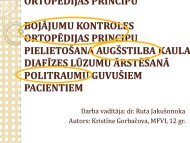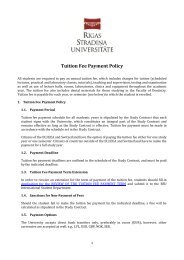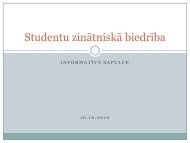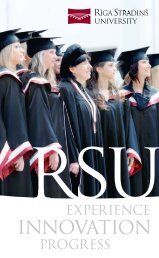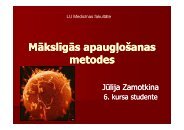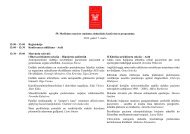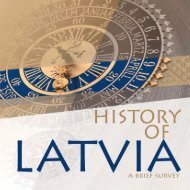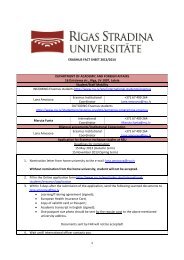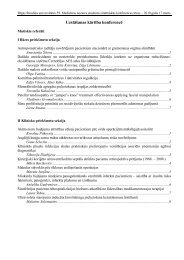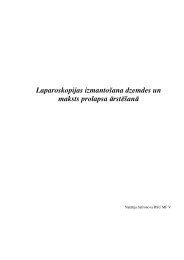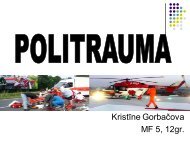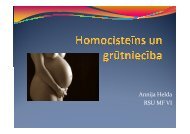Ecotourism in Latvia
Ecotourism in Latvia
Ecotourism in Latvia
- No tags were found...
Create successful ePaper yourself
Turn your PDF publications into a flip-book with our unique Google optimized e-Paper software.
F O R E S T S<strong>Latvia</strong>n forests are located <strong>in</strong> a mixed forest zone consist<strong>in</strong>g of northern coniferousand southern deciduous trees. You will f<strong>in</strong>d a p<strong>in</strong>e forest next to a l<strong>in</strong>dentree forest and a diverse spectrum of other species throughout. Because of theunique climate and terra<strong>in</strong>, nearly one quarter of <strong>Latvia</strong>’s forests grow on wetlands.Many plant and animal species that can surviveonly <strong>in</strong> constant habitats have found a homehere. The existence of the wetland forests ensures ahigh standard of biological diversity. Several of<strong>Latvia</strong>’s forests meet the criteriafor a natural forest. <strong>Latvia</strong>’sforests also afford a rich supply ofberries, wild strawberries, blueberries,raspberries and loganberries.The berry-pick<strong>in</strong>g seasonlasts from late June until lateSeptember. It is also the time forgather<strong>in</strong>g mushrooms. The most popular mushrooms are the edible boletus,orange cap boletus, chanterelles and rusulla. If <strong>in</strong> the 1930s <strong>Latvia</strong> was knownfor its butter and bacon exports, then today it is known for its export ofchanterelles. Apart from clearly marked private lands, the wealth of <strong>Latvia</strong>’sforests, berries, mushrooms and hazelnuts is accessible to anyone. 8 /9A characteristic feature of <strong>Latvia</strong>’s coast –slender Riga p<strong>in</strong>es.
Coastal fish<strong>in</strong>g traditions are anessential part of <strong>Latvia</strong>n culture.A fish<strong>in</strong>g expedition with localfisherman, <strong>in</strong>clud<strong>in</strong>g preparationof the catch, can be an unforgettableexperience.The fragrance ofsmoked fish isthe unmistakablecall<strong>in</strong>g card of acoastal fish<strong>in</strong>gvillage.The small harboursthat wereneglected dur<strong>in</strong>gthe Soviet era areonce aga<strong>in</strong> com<strong>in</strong>gto life andawait yachtsmen. By sail<strong>in</strong>gfrom harbour to harbour, it ispossible to traverse nearly halfof <strong>Latvia</strong>.Unique natural areashave survived <strong>in</strong> coastal lowlands,one of these be<strong>in</strong>gP a p e L a k eand its surround<strong>in</strong>g environment.It is a typical 1,200-ha coastal lake.Rare species of birds, such as thebearded tit, common and little bittern,the corncrake, the hen harrier, the littleand spotted crake, nest <strong>in</strong> the lake andits surround<strong>in</strong>gs. The lake and thenearby Nida mire are importantstopovers for bean and white-frontedgoose and curlews dur<strong>in</strong>g migration.The lakeshore boasts one of the fewbird-watch<strong>in</strong>g towers <strong>in</strong> <strong>Latvia</strong>.Every year millions of land-dwell<strong>in</strong>gbirds and thousands of migratory batstravel through the strip of dry land between Pape Lakeand the Baltic Sea.12 / 13Jürkalne (<strong>in</strong> English: “sea-mounta<strong>in</strong>”) – a place wherethe sea <strong>in</strong>vades the land.
M I R E ST e i ç i S t a t e R e s e r v e .Compared to other European countries, mires It covers an area of 19,337 ha and is thetake up a significant proportion of <strong>Latvia</strong>. 4.9% largest protected mire <strong>in</strong> the Baltic.of <strong>Latvia</strong>’s territory consists of open marshes. A raised bog covers the larger part of theAbout 50% of the mires are largelyterritory, but there are alsoundisturbed by human activity. With<strong>in</strong>19 lakes, bog pools, m<strong>in</strong>eralthis territory there are more than 20 protectedplant species. At least 15 speciesand natural meadows.soil islands, fens, swamps,of birds nest <strong>in</strong> mires and marshlands,The most <strong>in</strong>tensive peat<strong>in</strong>clud<strong>in</strong>g the crane, golden plover, blackcreation process <strong>in</strong> <strong>Latvia</strong>grouse, whimbrel, merl<strong>in</strong> and peregr<strong>in</strong>e.can be observed here.Dur<strong>in</strong>g periods of bird migration, theIt also has the largest concentrationof pre-migratorymires are importantrest<strong>in</strong>g-places for cranes and cranes <strong>in</strong> <strong>Latvia</strong>. An ancient Russian villagegeese. There are 10 protected of Russian Old Believers (people who hold<strong>in</strong>sect species and a rare speciesof snail. Mirespagan, beliefs) still exists onto the Russian Orthodox, as well as oldand marshes are alsoone of the marsh islands.highly valued by berry pickers for theThe mire can be entered only <strong>in</strong>wide range of berries that grow there,the company of a guide.<strong>in</strong>clud<strong>in</strong>g cranberries, cloudberries, cowberriesand bilberries. 14 / 15Tîre¬purvs and many other <strong>Latvia</strong>n mires are accessibleonly to the most adventurous visitors.
L A K E S A N D R I V E R S<strong>Latvia</strong> has over 12,500 rivers that stretch for 38,000kilometres, as well as 2,256 lakes that are biggerthan 1 ha, with a collective area of 1,000 sq. km.Eastern <strong>Latvia</strong>,where many ofthese lakes arefound, is known as “the Land of the Blue Lakes”.Nearly all <strong>in</strong>land waters are pollution-free andideally suited for swimm<strong>in</strong>g and fish<strong>in</strong>g.Although some of <strong>Latvia</strong>’s rivers have had their courses straightened, mostlarge- and medium-sized rivers reta<strong>in</strong> their natural contours. As a result, theirbanks are home to such now rare European wildlife as otter, beaver and commonk<strong>in</strong>gfisher.16 / 17Early morn<strong>in</strong>g by the riverside.Imag<strong>in</strong>e the song of the night<strong>in</strong>gale’s trill!
<strong>Latvia</strong> is one of the fewplaces <strong>in</strong> the Baltic Searegion where naturalsalmon spawn<strong>in</strong>g areasstill rema<strong>in</strong>. There areplenty of rivers suitablefor canoe<strong>in</strong>g and raft<strong>in</strong>g.G a u j a N a t i o n a l P a r k .The Gauja, <strong>Latvia</strong>’s longest river, is extremely popularwith tourists because none of its 452 kilometres has been changed from its orig<strong>in</strong>al course.For 85 kilometres the Gauja flows through an old valley that is theheart of the Gauja National Park. Nowhere else <strong>in</strong> <strong>Latvia</strong> will youf<strong>in</strong>d so many steep banks, rav<strong>in</strong>es, streams, sandstone and dolomitecliffs, and caves as <strong>in</strong> the old valley of the Gauja River with itstributaries. Like other national parks <strong>in</strong> the east of the Baltics, theGauja National Park <strong>in</strong>cludes natural territories relatively untouchedby man, as well as historic rural landscapes and important ancientmonuments. The park also offers walk<strong>in</strong>g trails, observation po<strong>in</strong>ts,rest areas, well-established camp<strong>in</strong>g facilities, car parks, cafes,various types of tourist cab<strong>in</strong>s, <strong>in</strong>formation centres andthe services of knowledgeable guides. 18 / 19The old valley of the Gauja –the most popular tourist site <strong>in</strong> <strong>Latvia</strong>.
R U R A L F A R M SThe soul of <strong>Latvia</strong> is revealed <strong>in</strong> the typical rural farmyard, where one lives <strong>in</strong> harmonywith nature’s laws and rhythms. It is a place where ancient traditions arerespected and annual festivals are joyously celebrated. On Lîgo eve (Summer solstice)the traditional bonfire is lit <strong>in</strong>almost every farm. Lîgotåji (the celebrantsof the festival) who, dur<strong>in</strong>g theday have gathered colourful Jåñu zåles(field flowers), head off <strong>in</strong> pairs toseek the legendary secret fern blossomthat blooms only once a year onthis night. The s<strong>in</strong>gle-family farm is an <strong>in</strong>tegral part of the<strong>Latvia</strong>n landscape. Many still look just as they did centuries ago. The <strong>Latvia</strong>nlandscape is also unimag<strong>in</strong>able without its stately old trees; oaks that are severalhundred years old can be found <strong>in</strong> farmyards, as well as <strong>in</strong> the fields. Hereas well, <strong>Latvia</strong> has become home to9,000 – 10,000 pairs of white storks.Today, an <strong>in</strong>creas<strong>in</strong>g number of farmersare open<strong>in</strong>g their farms to tourists.More than 140 farms offer bed-andbreakfastservices and a variety ofleisure activities. 20 / 21<strong>Latvia</strong> – a land where picturesque landscapesgreet the traveller at every turn.
P R O T E C T E D N A T U R E A R E A S<strong>Latvia</strong> has a long tradition of nature conservation. The firstlaws and regulations concern<strong>in</strong>g the use of forests were passedas early as the 1500s and 1600s. In the 1800s an effort wasmade to reforest the Baltic coastaldunes and the Gulf of Riga. In the1900s proposals for conservationareas were <strong>in</strong>itiated. The first protectedarea <strong>in</strong> <strong>Latvia</strong> was <strong>in</strong> theKurzeme region – Moricsala, anisland <strong>in</strong> Usma Lake.At present 8.5% of<strong>Latvia</strong>n natural territoriesare protected bylaw. There are 4 statereserves, 3 nationalparks, 22 nature parks,211 nature reserves, 6protected landscapeareas, and 1 biosphere reserve. Together, these placesmake up <strong>Latvia</strong>’s natural heritage; they are readyto offer the keen ecotourist a wealth of experience. 22 / 23 appleemeri National Park – wetland forest paradise.
<strong>Latvia</strong> has a wealth of spr<strong>in</strong>gs –a treasured source of pure dr<strong>in</strong>k<strong>in</strong>g water.π The <strong>Latvia</strong>n Institute, 2001Text: Valdis PilåtsLayout: Uldis SosnovskisEnglish translation: Aija Ozoliña, Måra PriedkalneChief Editor: Raimonds CerüzisEditors: Ieva Pîgozne, Juris Sma¬<strong>in</strong>skisPhotographers: R.Cerüzis, A.Eglîtis, M.Kundziñß, A.L<strong>in</strong>arts, A.Meiers, J.Pîgoznis, V.Pilåts,I.Prédelis, E.Véveris, J.Zalåns



